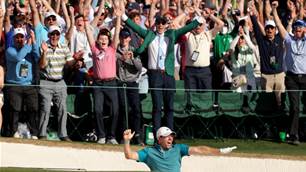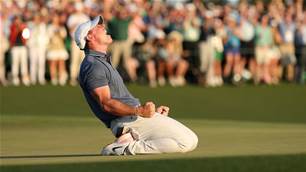The Masters has been run and won, and the great Rory McIlroy has fulfilled his destiny, despite being hunted down like a bloodied fox by the great hounds of our sport, Justin Rose, Ludvig Aberg, the ever-compelling Bryson DeChambeau, who thrilled us with sublime and ridiculous golf on a course we would sell a kidney to play. Augusta National remains golf's great muse. Augusta National is the champion forever.
Well, how good was that.
The Masters, again, was compelling, stellar, put-down-your-phone-and-suck-it-all-in entertainment for we slobs on the couch and in golf clubs around the land, acolytes who can nowt but marvel at the skills and nerve of these great players.
Yet while they thrilled us with their tight-rope-walk around Amen Corner and attempted mastery of this most difficult, confounding and counter-intuitive of sports, it is the golf course itself that is the undisputed, undefeated champion of our game.
Because Augusta National, a 6908-metre melange of grass and sand and meticulous, almost Japanese garden-like beauty, can tell stories.
The annual Masters tournament sports terrific leaderboards. And not only for the names on it, though they are the greatest players of our time. But for the dynamic, fractious nature of those leaderboards. Players can emerge onto it from everywhere, and they can shoot back out as quick as they came in.
A Masters leaderboard spikes like bitcoin on the stockmarket. Winthorpe! There’s a run on pork bellies! Go long on Reed! Short up Ludvig! Buy, buy! I mean sell! No, buy!
As a portal for story-telling, Augusta National is better than Netflix. Augusta National is golf’s Hollywood.

The course was created as, and remains, Dr Alister MacKenzie’s paean to Bobby Jones. In 1931 (Great Depression? What Great Depression? Fetch me an Ashton from the humidor, Buzby, and be quick about it) the pair went out into an old indigo plantation in Georgia, and Jones hit balls. And, the routes they traversed on Jones's high draw, MacKenzie routed fairways. And where his shorter irons landed, MacKenzie put greens.
It was effectively that simple.
MacKenzie, who learned to camouflage targets from his time serving in the Boer War (1899-1902), designed a masterpiece that continues to test, delight and torment golfers and spectators and anyone who had money on Bryson DeChambeau.
The beauty of MacKenzie’s muse is that on each hole there could be pleasure or pain, or both. There are gettable, or stuff-up-able, par-4s early - and, yes, you can call a 495-yard par-4 "gettable" if drives travel 330-yards early - followed by progressively, demonically stronger ones later on, when the heat is on - 10, 11, 14, 17.
The par-5s offer potential for eagles or double-bogeys, or triples or quads, or albatrosses - the collective noun of which is a "rookery" - as recorded by Louis Oosthuizen (No.2 in 2012) and Gene Sarazen ( No.15 in 1935, a “shot heard around the world”).
On the Saturday, on the second, Rory McIlroy chipped in for eagle. On the Sunday he made a fighting five, carrying a double-bogey on the first as baggage. He later double-bogied the 13th. He bogied 14.

And all of a sudden, in a tournament McIlroy appeared to be coasting in, they were coming from everywhere. Justin Rose, Ludvig Aberg, even Scottie Scheffler who'd been borderline anonymous. The hunting dogs were after the hound with blood on their lips.
Then Rory hooked a 7-iron around trees to six feet on 15, the shot of his or anybody's life, and the members of the golf club where I watched, some of them drinking breakfast beer, roared like Romans.
"Greatness," remarked Ian Baker-Finch in comms. "What about that shot by Rory."
"What are we watching?" implored our live blog man, Callum Hill. "This is an out of body experience."
Then McIlroy missed the eagle putt. Led by one. Rose birdied 18. Patrick Reed holed out on 17. McIlroy drew in a 7-iron from 184 yards to the uphill par-4 17th to two feet. What a shot. What a shot, dear sweet Jebus.
And still we watched, compelled, pupils like pool balls, sucked in like moths to the moon, as McIlroy's drive on 18 was perfect - "Yeeaaah!" sounded off the barflies - before the ball threatened to go in the sand - "no-no-no-no-noooo" - and then stopped just short - "yeeaaahhhh."
And we cackled like fiends.
Rory bogied 18 from nowhere. Play-off. Rose stiffed his approch. McIlroy stiffed closer. Our golf club roared. Rose rolled it by. And Rory McIlroy, dear sweet Rory McIlroy, rolled in a three-footer for the win of his life.
And our club roared stood as one and roared to lift the roof.
For such is the power of Augusta National.

Imagine playing it…
The late and great Shane Warne played Augusta and – how about his life - made a hole-in-one on 16, the only person to make one at the back right pin. The green jackets sent him a letter saying as much, along with a plaque and the mounted ball. Pretty good talking point for the great man's pool room.
The former Editor of this esteemed journal, Brendan James, played Augusta in 2013 (and this they Adam Scott won) after scoring one of the great Golden Wonka tickets when his name was pulled out of a ballot to play it. This golf writing life has its perks and while money is not one of them, going into a ballot after working at the Masters is one, and no argument.
Suffice to say our man James was super-excited about his round, and got halfway into Amen Corner and stood on the tee of the famous par-12th known as “Golden Bell” after a flower, and hit a 45-degree Sherman Tank that was, by conservative estimate, viewed 852,000 times on YouTube before the green jackets asked that it be taken off the popular streaming service.
Didn't stop him talking about it forever, however.
The mark of a good story.
Related Articles

Head, heart and elbow, it's Rory's Masters

Watch: Golf Australia's Matt Cleary talks Masters on ABC News













